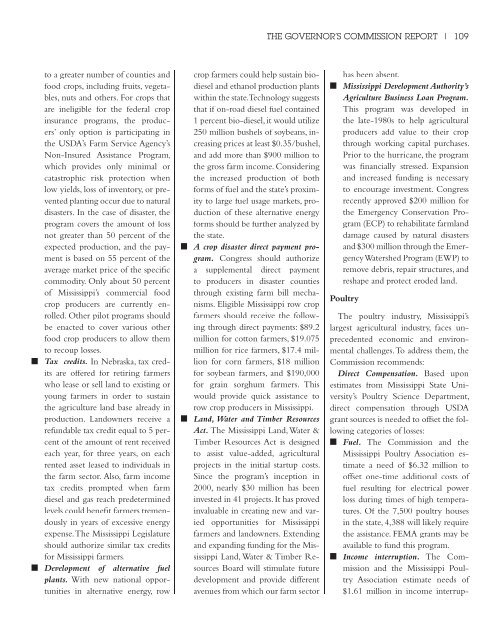Reports - Mississippi Renewal
Reports - Mississippi Renewal
Reports - Mississippi Renewal
- No tags were found...
Create successful ePaper yourself
Turn your PDF publications into a flip-book with our unique Google optimized e-Paper software.
THE GOVERNOR’S COMMISSION REPORT | 109to a greater number of counties andfood crops, including fruits, vegetables,nuts and others. For crops thatare ineligible for the federal cropinsurance programs, the producers’only option is participating inthe USDA’s Farm Service Agency’sNon-Insured Assistance Program,which provides only minimal orcatastrophic risk protection whenlow yields, loss of inventory, or preventedplanting occur due to naturaldisasters. In the case of disaster, theprogram covers the amount of lossnot greater than 50 percent of theexpected production, and the paymentis based on 55 percent of theaverage market price of the specificcommodity. Only about 50 percentof <strong>Mississippi</strong>’s commercial foodcrop producers are currently enrolled.Other pilot programs shouldbe enacted to cover various otherfood crop producers to allow themto recoup losses.■ Tax credits. In Nebraska, tax creditsare offered for retiring farmerswho lease or sell land to existing oryoung farmers in order to sustainthe agriculture land base already inproduction. Landowners receive arefundable tax credit equal to 5 percentof the amount of rent receivedeach year, for three years, on eachrented asset leased to individuals inthe farm sector. Also, farm incometax credits prompted when farmdiesel and gas reach predeterminedlevels could benefit farmers tremendouslyin years of excessive energyexpense. The <strong>Mississippi</strong> Legislatureshould authorize similar tax creditsfor <strong>Mississippi</strong> farmers.■ Development of alternative fuelplants. With new national opportunitiesin alternative energy, rowcrop farmers could help sustain biodieseland ethanol production plantswithin the state. Technology suggeststhat if on-road diesel fuel contained1 percent bio-diesel, it would utilize250 million bushels of soybeans, increasingprices at least $0.35/bushel,and add more than $900 million tothe gross farm income. Consideringthe increased production of bothforms of fuel and the state’s proximityto large fuel usage markets, productionof these alternative energyforms should be further analyzed bythe state.■ A crop disaster direct payment program.Congress should authorizea supplemental direct paymentto producers in disaster countiesthrough existing farm bill mechanisms.Eligible <strong>Mississippi</strong> row cropfarmers should receive the followingthrough direct payments: $89.2million for cotton farmers, $19.075million for rice farmers, $17.4 millionfor corn farmers, $18 millionfor soybean farmers, and $190,000for grain sorghum farmers. Thiswould provide quick assistance torow crop producers in <strong>Mississippi</strong>.■ Land, Water and Timber ResourcesAct. The <strong>Mississippi</strong> Land, Water &Timber Resources Act is designedto assist value-added, agriculturalprojects in the initial startup costs.Since the program’s inception in2000, nearly $30 million has beeninvested in 41 projects. It has provedinvaluable in creating new and variedopportunities for <strong>Mississippi</strong>farmers and landowners. Extendingand expanding funding for the <strong>Mississippi</strong>Land, Water & Timber ResourcesBoard will stimulate futuredevelopment and provide differentavenues from which our farm sectorhas been absent.■ <strong>Mississippi</strong> Development Authority’sAgriculture Business Loan Program.This program was developed inthe late-1980s to help agriculturalproducers add value to their cropthrough working capital purchases.Prior to the hurricane, the programwas financially stressed. Expansionand increased funding is necessaryto encourage investment. Congressrecently approved $200 million forthe Emergency Conservation Program(ECP) to rehabilitate farmlanddamage caused by natural disastersand $300 million through the EmergencyWatershed Program (EWP) toremove debris, repair structures, andreshape and protect eroded land.PoultryThe poultry industry, <strong>Mississippi</strong>’slargest agricultural industry, faces unprecedentedeconomic and environmentalchallenges. To address them, theCommission recommends:Direct Compensation. Based uponestimates from <strong>Mississippi</strong> State University’sPoultry Science Department,direct compensation through USDAgrant sources is needed to offset the followingcategories of losses:■ Fuel. The Commission and the<strong>Mississippi</strong> Poultry Association estimatea need of $6.32 million tooffset one-time additional costs offuel resulting for electrical powerloss during times of high temperatures.Of the 7,500 poultry housesin the state, 4,388 will likely requirethe assistance. FEMA grants may beavailable to fund this program.■ Income interruption. The Commissionand the <strong>Mississippi</strong> PoultryAssociation estimate needs of$1.61 million in income interrup-




